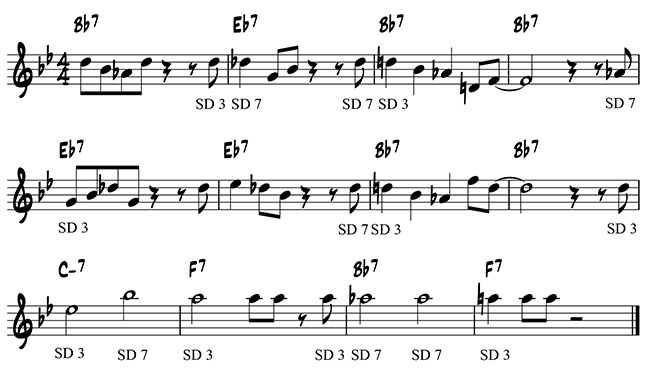Index - Introduction - Lessons
Chord Tone Solos with an Emphasis on Guide Tones
Lesson 12 is the same as Lesson 11, but with one alteration: each time you move from one chord to a different chord, you will use guide tones to connect the harmonies. For example, if you choose to play scale degree 3 at the end of the B flat 7 chord in measure 1, you will begin measure 2 with scale degree 7 of the E flat 7 chord, as shown in the example below.
Connecting the harmonies with guide tones can help us create more melodic solos. The guide tones outline the harmonies and make a smoother transition from one chord to the next. Also, in this lesson, you will compose longer phrases. Instead of focusing on short two-measure riffs, create four-measure phrases.

Part 1: Compose
Compose a solo on the B flat blues, using chord tones. Connect each harmonic change with guide tones, as shown in the example above. (For free blank staff paper, visit www.Music-Paper.com)
In measures 1 through 4, compose a four-measure phrase.
In measures 5 through 8, create a variation on the first phrase.
In measures 9 through 12, create a contrast to the phrase in measures 5 through 8.
Part 2: Memorize
Memorize the solo that you composed.
Part 3: Improvise
Improvise solos following the same guidelines as your composed solo. See Lesson 8 for a review of guide tones. Four-measure phrases can be harder to memorize than two-measure riffs. Improvise simple ideas and remember to connect each chord with guide tones.
Lesson 13: Building Intensity through Increased Range of Pitch and Dynamics

If you like this site, please share it with others!


Like Kyle Coughlin Music on Facebook
Follow Kyle Coughlin Music on Twitter